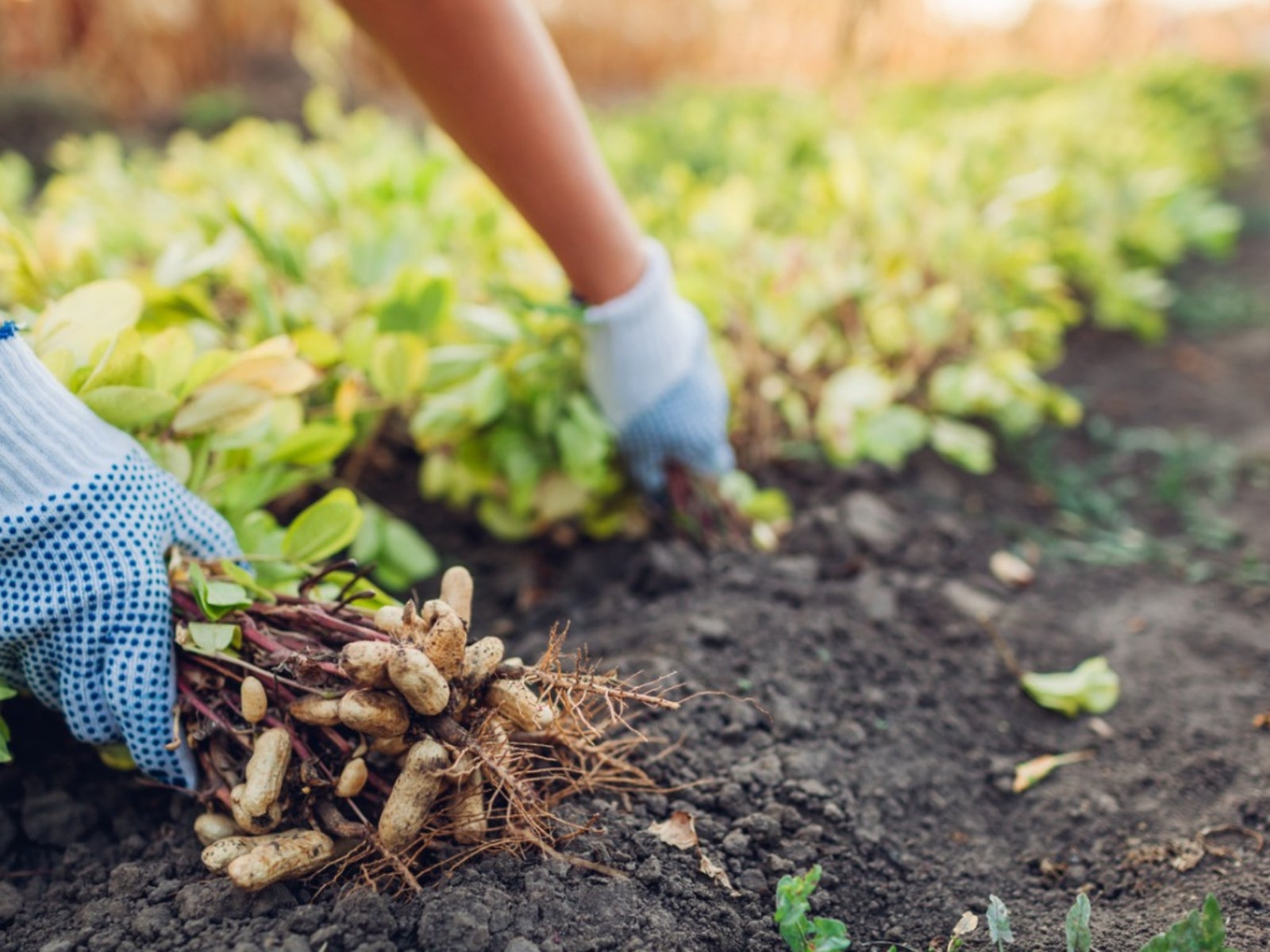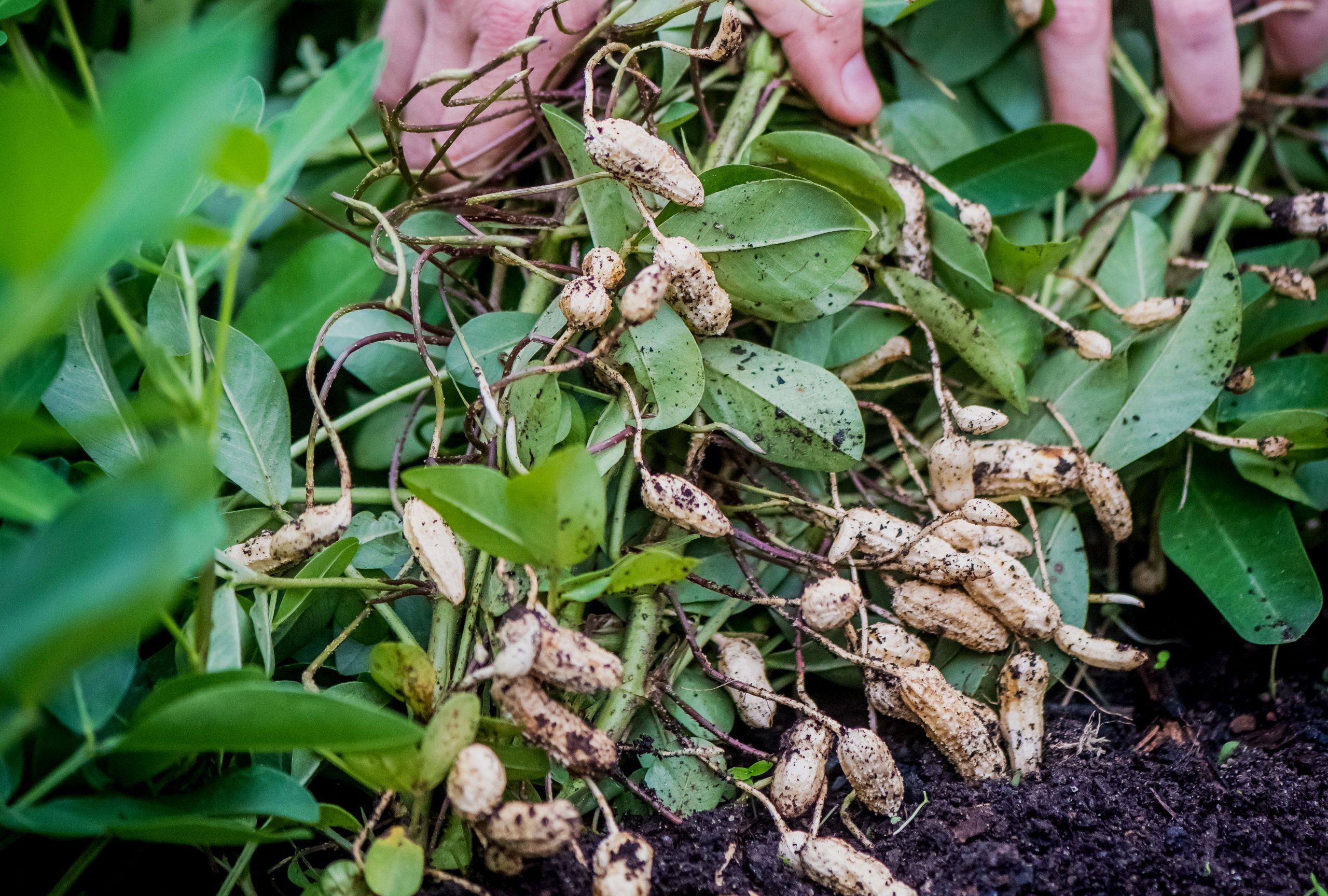To harvest peanuts, wait until the plant’s leaves turn yellow and the peanuts are fully mature. Then, carefully dig up the plants using a garden fork or shovel, ensuring not to damage the peanut pods.

Credit: www.gardeningknowhow.com
How to Harvest Peanuts: Step by Step Guide
Preparing For Peanut Harvest
Preparing for peanut harvest involves several important steps. One key aspect is choosing the right time to harvest, which ensures that peanuts are at their optimum maturity. This can be determined by monitoring the color of the pods and the appearance of the foliage.
When it comes to tools and equipment needed for harvesting, a few essentials include a digging fork or shovel, buckets or crates for collecting the peanuts, and gloves to protect your hands. Additionally, having a storage area ready is crucial for preserving the quality of harvested peanuts.
Before storing the peanuts, it is important to clean and prepare the storage area. This involves removing any dirt or debris, ensuring proper ventilation, and checking for any signs of pests or moisture. Proper cleaning and preparation will help prevent spoilage and maintain the freshness of the peanuts throughout storage.
Overall, following these steps will help ensure a successful peanut harvest and maintain the quality of the harvested peanuts.
Digging Up Peanuts
| Signs that peanuts are ready for harvest |
|---|
| 1. The leaves of the peanut plants turn yellow and start to die off. |
| 2. The peanut pods have reached a mature size and the outer shells are firm to the touch. |
| 3. The peanut plants have fully grown and the pegs have penetrated the soil beneath them. |
To harvest peanuts, it is important to follow a few key steps. Firstly, loosen the soil around the peanut plants to make it easier to lift the plants later. Use a garden fork or shovel to gently loosen the soil without damaging the peanut pods. Carefully lifting and removing the plants from the ground is the next step. Make sure to lift the plants by the main stem or base to avoid damage to the peanut pods. Shake off any excess soil from the plants and separate them from the foliage. Let the plants dry in a well-ventilated and shaded area for approximately two weeks. After this drying period, the peanuts are ready for further processing or storage.
Drying And Curing Peanuts
|
Shaking Off Excess Dirt And Debris
When harvesting peanuts, one important step is to shake off excess dirt and debris. This ensures that the peanuts are clean and ready for further processing. To remove excess dirt, gentle cleaning tools can be used. These tools help to avoid damaging the peanuts while effectively getting rid of any unwanted dirt. It’s important to handle the peanuts with care during this process to maintain their quality. By shaking off excess dirt and debris, the peanuts will be in a better condition for storage or further processing.
Sorting And Grading Peanuts
In the process of harvesting peanuts, sorting and grading the peanuts play a crucial role in ensuring the quality of the final product. Sorting peanuts based on size and quality is the first step in this process. Peanut farmers use various methods such as screens and mechanical separators to separate peanuts of different sizes. This helps to achieve uniformity and consistency in the final product.
Identifying and removing damaged or unhealthy peanuts is another important aspect of sorting. This is done by carefully inspecting each peanut and discarding any that show signs of disease, insect damage, or mold. By removing these peanuts, the overall quality of the batch is improved.
Understanding the grading system for peanuts is essential for both producers and consumers. Peanuts are graded based on factors such as size, color, and shell quality. The grading system provides a standardized way to classify peanuts, allowing buyers to make informed decisions based on their specific requirements.
Storing Properly For Longevity
Proper packaging and storage containers are crucial for ensuring the longevity of harvested peanuts. When storing peanuts, it is important to choose containers that are airtight and can protect the nuts from moisture and pests. Make sure to store peanuts in a cool, dark, and dry location, as these conditions can help prevent spoilage. Regularly monitor the stored peanuts for any signs of spoilage or pest infestation, such as mold growth or pest activity.
If any issues are detected, take appropriate measures to address them immediately. By following these storage guidelines, you can enjoy the freshness and flavor of your peanuts for a long time.
Troubleshooting Common Harvesting Issues
Harvesting peanuts can sometimes come with its challenges. One common issue growers face is peanuts that are difficult to remove from the ground. This can happen when the peanuts are not fully matured or when their shells are underdeveloped. To overcome this problem, it is important to handle the peanuts with care and use the right equipment for harvesting. Gentle digging around the plants can help loosen the peanuts from the soil without damaging them.
Another challenge that may arise during the harvesting process is the presence of mold, pests, or rodent damage. Proper storage techniques can help address these issues. Storing peanuts in a cool and dry environment can minimize the risk of mold growth, while using appropriate containers and implementing pest control measures can prevent damage caused by pests and rodents.
Tips For Maximizing Peanut Harvest
Rotating crops is an important practice for maintaining the health and productivity of peanut plants. By alternating peanuts with different crops in different seasons, you can prevent the buildup of diseases and pests that specifically affect peanuts. This practice promotes soil health and nutrient balance, reducing the need for excessive chemical treatments.
Successful peanut harvests require ongoing maintenance and care. This includes regular irrigation to ensure adequate moisture levels, as peanuts require consistent moisture throughout their growth cycle. Regular weeding is also crucial to prevent competition for nutrients and maximize plant growth. Additionally, monitoring for pests and diseases helps to catch and address potential problems early on, ensuring a healthy crop.
Efficient harvesting techniques can significantly boost productivity during peanut harvests. One common method is to wait until the peanuts are fully mature, indicated by the yellowing of foliage, before starting the harvest. This ensures optimal peanut quality and yield. Using mechanized equipment, such as a peanut digger or combine, can also speed up the process while minimizing labor requirements. Proper drying and curing techniques are vital to prevent mold growth and preserve the quality of harvested peanuts.
Frequently Asked Questions On How To Harvest Peanuts
How Long Does It Take For Peanuts To Mature?
Peanuts typically take about 100 to 130 days to mature from planting to harvesting. The exact time can vary depending on the peanut variety, climate, and growing conditions. It’s important to regularly check the plants for signs of maturity, such as yellowing leaves and dried pods, to determine the optimal time for harvesting.
Can Peanuts Be Harvested By Hand?
Yes, peanuts can be harvested by hand. To do this, carefully pull the peanut plant from the ground and gently shake off any excess soil. Hang the plants in a well-ventilated area to dry for about two weeks. After drying, remove the peanuts from the plants and store them in a cool, dry place until ready to consume or further process.
Should I Wash Peanuts After Harvesting?
It is not necessary to wash peanuts after harvesting, as this may introduce moisture that could lead to spoilage. Instead, gently brush off any visible dirt or debris from the peanuts. If you find that the peanuts need cleaning, use a soft cloth or brush to remove any remaining soil, but avoid getting the peanuts wet.
How Do I Know When Peanuts Are Ready To Harvest?
To determine if peanuts are ready for harvest, gently dig up a few plants and check if the pods have started to mature. Mature pods will have a papery feel and the outer shells will have turned brown. Additionally, the leaves on the plant will start to yellow and wither.
Timing is crucial, so keep a close eye on the plants to ensure optimal harvest.
Conclusion
To wrap it up, harvesting peanuts requires careful planning, timing, and the right techniques. By ensuring the soil is well-drained, the plants are mature, and the weather conditions are favorable, you can maximize your peanut yield. Remember to gently pull the plants from the ground and allow them to dry in a well-ventilated area.
Finally, remove the shells and store the peanuts in a cool, dry place for long-lasting freshness. Happy harvesting!

